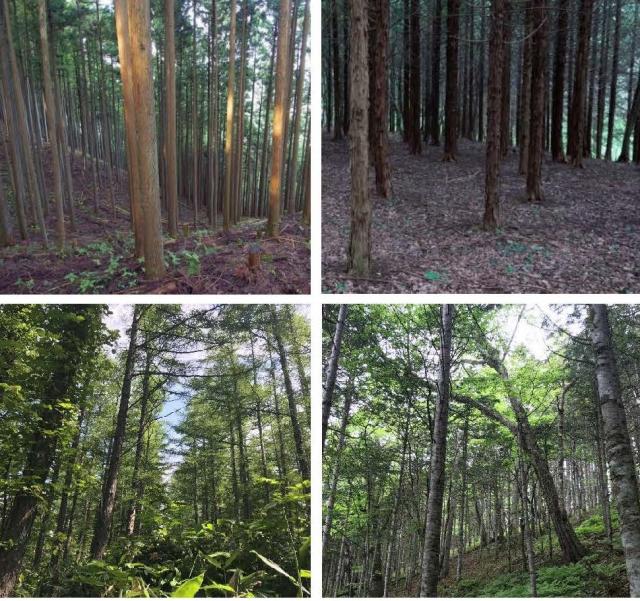Home > Research > News > Special Program for IUFRO World Day > Static event > Exploring Plantation Management for Reconciling Forestry and Biodiversity Conservation
Update:September 27, 2021
Main content starts here.
Exploring Plantation Management for Reconciling Forestry and Biodiversity Conservation
Kazuhiro Kawamura(Department of Wildlife Biology)
Background
Plantations for timber production are generally considered of lower biodiversity value than natural forests. However, the factors determining biodiversity in plantations remain unclear. Furthermore, regions with different climates, topographies, and landscapes have different biological communities, and many animals move seasonally (e.g., bird migration). Thus, the effects of plantation management on biodiversity shall vary among regions and seasons. I aim to propose plantation management methods that can maintain and improve biodiversity (mainly focusing on birds) responding to regional and seasonal variations.
Timber Plantation in Japan
Timber plantations in Japan are principally monocultures of conifer species [Cupressaceae (hereafter cypress family): Japanese cedar Cryptomeria japonica, Hinoki cypress Chamaecyparis obtusa; Pinaceae (hereafter pine family): Japanese larch Larix kaempferi, Japanese red pine Pinus densiflora, Todo fir Abies sachalinensis]. Cypress family species have been planted nationwide, mainly in the warm regions. In the cool regions, pine family species have been planted widely. Planted tree species are also likely to have strong effects on biodiversity in plantations.

Plantations of four different conifer species in Japan (upper: cypress family [left: Japanese cedar, and right: Hinoki cypress], lower: pine family [left: Japanese larch, and right: Todo fir]).
Recent Findings
A systematic review and meta-analysis on biodiversity of plantation in Japan revealed that habitat function of plantations differs among planted tree species. Planted tree species is one of the important factors determining biodiversity of plantations. In pine family plantations, abundance or richness for many taxa did not significantly differ from those in natural forests, suggesting the plantations kept habitat functions. By contrast, in cypress family plantations, abundance or richness for all analysis groups except understory abundance was significantly lower than those in natural forests. Even in cypress family plantations, some management methods (e.g. thinning) can lead to enhancing biodiversity.
Moreover, the function of plantations as vertebrate habitats was generally higher in winter than in the breeding season (spring-summer). To improve habitat function of plantations for conserving biodiversity, management methods should be considered for each planted tree species, separately, and also for both seasons.
Details information on this topic is available in Kawamua K. et al. (2021) Journal of Forest Research, 26:3, 237-246.
https://www.tandfonline.com/doi/full/10.1080/13416979.2021.1891625
Future Perspective
Short term
I would like to propose an option for specific plantation management conserving biodiversity in Hokkaido, northern Japan. Abundant natural forests remain and the largest area of plantations (mostly pine family) among Japanese prefectures exists in Hokkaido. Many migratory birds are known to breed in Hokkaido, but also some birds overwinter in harsh climatic conditions (e.g., low temperature and heavy snow) in winter. Thus, I am examining the effects of plantation management on bird communities both in the breeding and wintering seasons.
Long term (20-30 years)
I aim to reveal that how plantation management has consequences for the abundance of each bird species or group in each season across Japan. For example, I will indicate the effects of harvesting area, stand age, and the amount or quality of mixed broad-leaved trees, in detail. As far as possible, I will also clarify the processes underlying these patterns. Furthermore, to take account of changing climate and plantation states in Japan, I will assess the previous impacts of these changing environments on bird communities to date, and predict future changes in bird communities in response to climate change and forest management.
Expectation for International Network
Plantations have expanded worldwide, and now account for 7% of the world’s forests. Among the world countries, Japan has a long experience for managing plantation for timber production. Our results can provide valuable knowledge for the management of plantations not only in Japan, but for other regions in the world. However, plantations in other countries are often very different in terms of planted tree species, management methods, and environmental conditions. Furthermore, for migratory species, not only conservation in breeding areas, but also that in wintering grounds or along migration routes would be needed. Therefore, to understand the habitat functions of plantations and manage plantations for biodiversity conservation on a global scale, it is necessary to cooperate with researchers from different countries. I would like to actively work thorough international networks of researchers in this area.
Copyright © Forest Research and Management Organization. All rights reserved.
